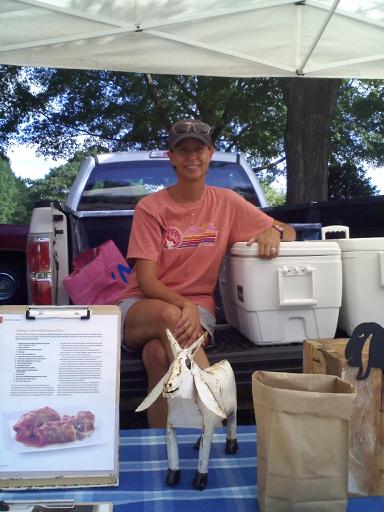From the Asia Times Julian Delasantellis gives us some real insight about Goldman Sach's plans for our world (and he's newly a believer). (I told you it was Government Sachs. Try not to get too bored as you read about how your retirement was stolen from you by the machinations of the Gold Men who have many, many tricks for your money markets.) (Emphasis marks added - Ed.)
*("Sanford, Ensign, Pickering, and other like-minded members of the Republican prayer brigade may come on like uptight Omega-fraternity elders Doug Neidermeyer and Greg Marmalard in Animal House, but when the sun goes down, they’re putting the tango records on the hi-fi, adjusting their cravats, and mimicking the moves of Otter, the Delta House leader and lethal stickman.")*
Suzan ____________________Goldman Sachs, the Lords of Time Just for the moment, let's pretend that James Cameron's 1984 The Terminator was being made for the first time today, and, instead of the evil robots emerging from the fatally misguided foundries of Cyberdyne Systems, they came from the dark laboratories of Goldman Sachs.
From out of the future, a warrior is sent back in time to warn the present.
"You still don't get it, do you? They'll find your money!! That's what they do! That's all they do! You can't stop them! They'll wait for you! They'll reach down into your bank account and tear its f*&^*^g balance out!"
"Now just wait one cotton-picking moment!" I hear many of you saying. A few weeks ago, in my review of Matt Taibbi's Rolling Stone-published anti-Goldman Sachs screed, I demurred, advancing an argument that, although Goldman certainly proudly wielded the sharpest elbows in investment banking, they were not the eternal center of a global nefarious conspiracy of plutocrats that has been making the lives of average people miserable since the 1920s. (See Goldman good but not that bad, Asia Times Online, June 9, 2009).
I received a number of thoughtful and well considered e-mails over my disagreement with Taibbi, many making helpful and constructive suggestions on the order of "Up against the wall and die, you capitalist sellout rat pig . . . " Therefore, one may consider this report on Goldman an attempt to return to the side of the angels. It's not - well, maybe it is. It's just that, as another chalk outline is drawn on the mean streets of international finance, once again Goldman's prints are found on the scene.
A few weeks ago, Goldman surprised the markets yet again, reporting second-quarter earnings at US$3.44 billion, much higher than expected, and, following similarly impressive results from the first quarter, almost back to the profit levels the bank, back when it was a buccaneering investment bank rather than the supposedly more sedate commercial bank it is now, was earning during the easy money days of 2007. Goldman's report was particularly curious in that two of its main Wall Street competitors, Bank of America and Citigroup, were able to report no such cornucopia.
Where were the profits coming from? Certainly not from intermediation, the bringing together of borrowers and lenders that is supposedly the core function of banking. There's just not enough economic activity currently going on to justify that much profit from standard intermediation. John Hempton of the Clusterstock blog suggests that Goldman is brokering sovereign wealth fund (SWF) purchases of US and British debt securities, but it is doubtful that the sharp operators running the SWFs would be leaving this many crumbs on the table.
Goldman's chief financial officer, David Viniar, attributes the outstanding results to "basic blocking and tackling", American football cliches for hard work at the business fundamentals. As the first 24-hour news cycle following the release came to an end, most observers, having generated no real alternative, were forced to accept the official story.
Then people remembered the bizarre spy caper story that ran the previous week, a story that we'll call, for lack of a better word, Codefinger.
On July 4, US Federal Bureau of Investigation (FBI) agents arrested one Serge Aleynikov, up until early June a well-paid Goldman Sachs vice president for equity strategy quantitative analysis, or "quant", who worked for the previous two years on, as his Linkedin page put it,
Lead development of a distributed real-time co-located high-frequency trading platform. The main objective was to engineer a very low latency (microseconds) event-driven market data processing, strategy, and order submission engine. The system was obtaining multicast market data from Nasdaq, Arca/NYSE, CME [Chicago Mercantile Exchange] and running trading algorithms with low latency requirements responsive to changes in market conditions.The FBI affidavit took the above gobbledygook and, straining it through the cheesecloth of the law, came up with the crime. From the charging affidavit of Aleynikov:
The defendant, unlawfully, willingly, and knowingly, without authorization, copied . . . downloaded . . . communicated and conveyed, a trade secret . . . a product that is produced and placed in interstate and foreign commerce. With the intent to convey that trade secret to the economic benefit of someone other than the owner thereof . . . ALEYNIKOV, while in New York, copied without authorization, proprietary computer code belonging to a financial institution in the United States and uploaded the code to a server in Germany.A few canny observers took his Linkedin description of what he was doing at Goldman, combined it with the affidavit's claim that he was stealing from Goldman, put the two together, concluded that whatever Goldman was doing with its "very low latency (microseconds) event-driven market data processing, strategy, and order submission engine", which Aleynikov and others call "high frequency trading", it had some value because apparently Aleynikov was stealing it with the obvious intent to sell or give it to somebody else.
A few noted that he had started his education at Moscow's Institute of Transportation Engineering. Good God! Was he the spy going back to the cold, a deep-cover agent in the service of Russia's FSB, the successor to the KGB?
And what did it say about how Russia compares the relative importance of Goldman Sachs and the US government that, having this supposed well-trained and resourceful operative, they allegedly chose to put him at Goldman instead of at the Central Intelligence Agency or the Pentagon?
But just what was he doing? What was Goldman's secret? What was high-frequency trading?
Most people know just enough about the workings of the US stock exchanges to really put their fortunes at risk in it. Part of that is knowing the precise mechanics of just how a stock trade is executed.
At least for the New York Stock Exchange, many people probably think that trades are executed through the floor-based "specialist system". This was the process illustrated in Oliver Stone's 1987 movie Wall Street; in it, when a trade was to be executed, a representative from the brokerage of the buyer or seller received a message from the brokerage, and walked the floor until he was in the actual physical presence of a floor trader called a "specialist", a representative of a firm that has promised the exchange that it will "make a market", that is, buy from retail sellers and sell to retail buyers, in the stock in question.
This they do by always maintaining and declaring a so-called "two-way" price, at which they are willing to buy a stock from the a public that might want to sell, and a higher sell price that they will use to sell stock to those who want to buy. Thus, by "making a market" in the stock, by buying low and selling high all day long, the specialist firm earns its operating profit, frequently a very nice little operating profit.
But the specialist system was never adopted for the NASDAQ, and, for about 97% of the trades currently on the NYSE, it doesn't work that way either; these days, the actual floor of the stock exchange serves not much purpose other than being television news' Potemkin village for modern-day capitalism. The real action is happening nowhere near the floor, inside the data servers of what are called "electronic communications networks" (ECN), like the ones operated by the New York Stock Exchange/Euronext conglomeration, one, OMX, operated by NASDAQ, and, equally or perhaps more important than the previous two, an independent ECN run by a company called BATS.
You, the average investor, may be involved in the stock market because you hope that, over 25 years or so, the shares you own of Google will appreciate so much as to be able to fund a comfortable retirement. That's not the case at the ECNs - they're breathing, eating, living and dying, every single hour of every single day, the bid/ask spread.
If you hear a media report telling you the price of a stock, say, "GE up three quarters" or "ExxonMobil up an eighth", what you are most likely hearing is news of the most previous actual trade the stock was exchanged at. This does not take cognizance of the bid/ask spread. When you do understand it, you will have taken a giant step forward in your understanding of financial markets, for playing the bid/ask spread is at the core of what real financial market professionals call trading.
All during the American trading day, you can see on the BATS web site http://www.batstrading.com/home) bid/ask spreads in action in near real time. A recent example had Wells Fargo bank, WFC, being quoted at a bid ask spread of 24.60 bid, 24.61 offer; the standard jargon here would be to then quote WFC as "60-61".
What this means is that some trader using BATS thinks he can make money buying WFC at 24.60 and immediately selling 24.61. Granted, it's only a penny, but if it's on a million shares, it's $10,000, for what would probably be only a few seconds work, the time the trader held the stock until he could dump it.
Looked at it this way, the bid/ask spread appears in a new light; what it actually is is the business profit margin of the trader making the two-way market in WFC. I'm sure that if he had his way, the trader would rather be making a lot more than a profit margin that comes out to about .04% (1 cent divided by $25) per trade; if he could quote a spread of, say, 25.00-50.00; his profit margin would be 100%.
But in that case, the trader would be faced with the same age-old dilemma that all businesses with wide profit margins face - the fact that competitors can come in and, in exchange for a less-bountiful profit margin, try to quote a narrower spread in order to steal some of the lucrative business from the trader quoting the big spread.
That's the big difference between trading under the old NYSE specialist regime and trading with modern day ECNs. Specialists were granted an essential monopoly in the business of making bid/ask spreads in their individual stocks. With the ECNs, any qualified trader can put his own individual bid/ask spread on the board; this competition acts to narrow the spread through arbitrage.
Then again, unlike the standard practice with the specialists, on the ECNs, the traders putting up spreads they're willing to buy and sell stock at are under no obligation to keep them there should prices start to move so violently that operating a profitable (for the trader) two-way market can't be maintained. This was the case on the NASDAQ during the crash of 1987, with prices falling so far and so fast that traders simply stopped answering the phones of those requesting them to make a two-way price.
This is the real essence of the trader's day-to-day life, intently watching and altering bid/ask spreads to steal business from other traders but not being so aggressive with a buy price that they wind up buying stock at a price above that which they can sell it out for, what is known as a "crossed spread".
What is it that moves the price of the stock, the bid/ask? Here, it's not too much different for a five-minute time interval than for a five-year interval - volume. If, at any one moment, the combined market makers of an ECN have, say, five million shares of Yahoo that they're willing to sell at 15, and if somebody comes in and buys a million of those shares, the other market makers are going to know that Yahoo is hot, that there's buzz about it, that the train is leaving the station. The other 4 million shares will be marked up accordingly, maybe to 15.20-25.
Now, things are getting interesting. Let's transfer the above example from today's brave new world of the ECNs to the old days of the specialist system. Let's say that you're the retail trader that wants that million shares of Yahoo. First, you do it the old-fashioned way. You call your broker, read the trade off, he reads it back to you a few times, and then, only then, the order is sent by the brokerage to its trader on the floor, who would walk it to the specialist.
For the sake of the example, let's say that, at the same time your order is making it through the bowels of the brokerage, you have a buddy with a cellphone standing next to the Yahoo specialist. Quite illegally, you call him, tell him to execute the order.
He does, instantly, at the original ask price of 15. Then, your brokerage's floor trader comes lumbering into view. He still has your trade in his hand that he is delivering the old fashioned way, but now, the specialist, having sold one million shares to your buddy, has raised the price to sell the next million shares to 15.25.
Okay, the broker delivers an order to buy a million shares of Yahoo at 15.25. Who wants to sell? Wouldn't your buddy, he just bought at 15 - selling a million shares at 15.25 nets a quick $250,000 profit, which, he, presumably, will share with you.
In financial lingo, speed of order delivery is called "latency", in that a system that executes orders slowly is said to possess "high latency", while a fast system, like your friend at the other end of your cellphone, possesses "low latency". Didn't Serge Aleynikov's Linkedin online resume note that he specialized "in architecture and implementation of massively concurrent low-latency, highly available distributed systems in the areas of high-frequency trading?" Slowly, the backstage curtain opens to reveal Goldman's new trick.
"But you can't outrace a computer-based ECN network the same way you can human specialists, can you?" you might ask. To paraphrase George Bernard Shaw in a quote made famous by senator Robert F Kennedy, Goldman Sachs dreamt things that never were, and said "Why not?".
According to press reports, this is how one of Serge and Goldman's "trading algorithms with low latency requirements responsive to changes in market conditions" might have worked.
Let's say that you're a big-hitting retail investor, such as the California state pension fund Calpers, or a big Fidelity mutual fund. Today, you've got a big hankering to buy a lot of stock, say, 10 million shares of the QQQQ Nasdaq 100 exchange traded fund (ETF).
This ETF trades an average of about 140 million shares a day, so someone wanting 10 million at a pop is not all that unlikely. You've got the credit for the trade, but there's one big problem. If your broker "shows" the market an order this big, there's just no way that the other market makers on BATS or another ECN are not going to mark up the price the shares are offered at, causing you to pay more than you want to on your trade.
What to do? Well, one way to try to fool the market would be to split up your order among lots of different traders making a market in QQQQ, say, 100 orders of 100,000 shares each.
The hope here is that the trades will go through underneath the trader's radar. That's entirely possible; human traders can only process so much information even when not distracted - it might just work.
It might just work with human traders - not with Serge's algorithms run on Goldman's computers.
Apparently, what Goldman's computers can do is incredibly sophisticated pattern recognition that can tell when somebody is trying to sneak in a big order. Not only that, they've apparently backward engineered the software to recognize what the market looks like before many types of big (within the context of about a few seconds to up to 15 minutes of trading) price moves.
Once you know that big orders are coming, and if you have Goldman's powerful big computers, making guaranteed easy money is a snap. While it may take a second or two for the multitude of smaller orders to hit the market, Goldman has already been in the market and gone, buying up most or all of the 10 million share order. When the buy order from the retail customer finally does hit the market, guess who's there to fill it? There's Goldman, selling the shares it just picked up maybe a second or two earlier at a lower price for a tidy little profit, the sum of which apparently went a long way towards making Goldman's $3.44 billion of earnings last quarter.
Many think that these trading mechanism's are inherently unfair, since, by their very nature, they disadvantage smaller traders in favor of the trading power financed by Goldman's wealth. Therefore, are the exchanges and ECNs working to stop Goldman and the others trading in this manner, so as to restore a level playing field?
Yeah, right. As the speakeasies said during Prohibition, may I take your hat and coat, Mr Capone?
Let's say that, over in Galaxy M87, in the constellation of Virgo, they're real aces at writing high-frequency trading algorithms; still, they're not going to be able to profit in this market like Goldman has. M87 is 50 million light years from Earth; any order originating from M87's computers will take 50 million years to reach the exchange. Truly, that's very "high latency".
Here on Earth, firms like Goldman seem to have discovered that, even with orders moving through the system at the speed of light, the distance from their computer to the ECNs computer makes a difference. With success or failure in getting to the market sometimes only a matter of milliseconds, it is only natural that many of these high-frequency traders such as Goldman have successfully worked to get their computers as physically close as possible to the ECN's computers.
As in, like right next to them, what they call "co-location".
One final way that the exchanges support firms doing this type of trading is not that hard to understand. How different would the result of most American football matches be if one team had to divulge its whole playbook, including what plays its offense was about to run, on a fairly regular basis? In exchange for the liquidity that these high-frequency traders provide the market, the exchanges allow them to "peek" at other traders' order books, the listing of what trades, at what prices and at what volumes, the traders will be delivering onto the marketplace up to a half of a second before they are executed.
For traders with powerful computers and trading algorithms like Goldman's, a half a second is all they need; sometimes they'll get the job done if they can see orders but a few microseconds before they're fired off.
The exchanges defend this cozy practice by saying that it helps average traders by stopping their trades before they would be delivered to the exchange to be filled at a bad price. Maybe that's true every once in and a while, but, for many other observers, this smacks heavily of frontrunning, the practice where a brokerage, seeing a big order come in from one of its customers, trades in the order's direction in order to profit from the market move that will ensue from it.
Frontrunning is illegal. Sneak and peeks, like most everything else Wall Street has developed this decade and beyond, is not. Yesterday's criminal may be today's technological avatar, but that still leaves the basic act involved a crime, doesn't it?
With all these new games it has to play, it's no wonder that Goldman wanted Codefinger Serge to come back to the party with his stolen trading code. If you're one of those people who hate computers because you've fried every one you've ever touched, Goldman Sachs has a server in Germany it wants you to find.
Goldman didn't originate high-frequency trading, and it's not the only shop doing it now. For years, observers have been astounded at the amount of money Dr James Simons' Renaissance Technologies hedge fund would regularly make; frequently, billions of dollars a year. Nobody really knew just what Simons was doing to earn these riches, but it is now becoming accepted that what he was doing in the early part of this decade Goldman is doing now. This year, however, Simons is reporting what he calls a "dismal performance" for Renaissance, as, apparently, Goldman's massive financial firepower is arbitraging Simons' profits away.
High-frequency trading's high-priced defenders say that the practice, by hugely expanding total volume on US stock exchanges, improves the prices that average, retail investors get on their trades. With up to 70% of trading on US exchanges now believed to be some sort of high-frequency trading, this is probably true. A trade for 100 shares of Boeing that previously might have filled at $43 might now get filled at $42.85. That's an extra $15 in your pocket.
The question is, what, if any price, does society pay for your extra 15 bucks?
One thing that high-frequency trading conclusively proves is just how much the deck is stacked against small investors. If you're buying and holding your stocks for retirement 30 years hence, this probably doesn't matter much; but if you're trying to short-term or day-trade this market, from your den with your kids' toys in the corner, over your little DSL broadband line, you're going up against the Goldmans and their massive computer firepower. That makes about as much sense as betting the mortgage on the prospect of your gymnasium's pick-up basketball team of insurance agents and furniture salesmen beating the Los Angeles Lakers. If it ever really was possible to day-trade stocks away from the floor, it's not now; the whipsaws that high-frequency trading can generate will murder you.
Some have wondered, with high-frequency trading now sometimes estimated to be about at 70% of total stock market volume, what would happen if it just suddenly disappeared? What would happen if, through technical glitches or just some manner of malfeasance, the big computers located right next to the exchanges' computers just stopped sending prices to the exchange?
Obviously, bid-ask spreads would widen, perhaps sharply, in its early stages, and that might be mis-identified as a crash. What if somebody like Serge, as the SWAT team closes in, tries to save his skin by holding the whole stock market hostage, threatening to send in code that would permanently crash the system if taken?
With such complex algorithms, partially or fully understood by so few if any real people, reconstructing the system and all its busted trades could take forever.
In his New York Times column, Nobel economics prize winner Paul Krugman, quoting UCLA economist Jack Hirshleifer, said practices such as high-frequency trading, while providing private profitability for Goldman and its other practitioners, contribute nothing but "social uselessness" to society as a whole. In this, the practice resembles much of what else has come out of warped laboratories and minds, things like credit default swaps, collateralized debt obligations and the creative interpretations of value by the ratings agencies, of the financial system these past few years.
Something like a Tobin Tax, first proposed by Nobel Prize-winning Yale economist James Tobin, a worldwide levy on short-term financial speculation, would probably stop high-frequency trading dead in its tracks, but if President Barack Obama can be charged with socialism just for trying to revive the economy in precisely the same way his predecessors have, he'd probably be equated with Robespierre if he ever proposed a Tobin Tax.
What strikes me most about high-frequency trading is the opportunity costs, what society loses by deploying scarce resources in the fashion it does instead of towards more productive uses.
Forty years ago last month, I sat with my father in front of our fuzzy black-and-white TV to watch men walk on the moon. The young president John F Kennedy had tasked all the nation's considerable technological and scientific resources to accomplish this one goal before the decade's end, and although he would not live to see it, and even after the tragic 1967 fire on board Apollo 1 that was thought to put the goal out of reach, in 1969 it happened, to the astonishment and delight of the entire human race.
Fast forward 40 years. Next year, the Space Shuttle will be retired (if NASA had any sense, it would be delivered right now to a car dealer for a government $4,500 cash-for-clunkers credit), and, for the first time in nearly 50 years, America will have no capability to send a human into space. At present, the biggest issue in US space policy is the substandard toilets America has delivered to the International Space Station. They apparently were not engineered with sufficient robustness of capacity to handle the Russian cosmonauts' high-roughage diet, currently resulting in frequently the most dire conditions imaginable up there in space.
The contrast between NASA's crappy space toilets and Goldman's Midas-capable computers perfectly illustrates the public policy choices America has made these past few years. Private consumption and investment that benefits only the few is considered glorious, while public consumption, from small communities cutting math and science instruction so they can fully fund the school football team, all the way to paltry national support for basic scientific research, is forever the hungry orphan with an empty plate always begging for more.
To make the metaphor even more glaring, they actually call the PhDs who come up with ideas like high-frequency trading "rocket scientists", deserving of respect and good pay just as long as they stay far, far away from any real rockets.
Sarah Connor terminated the Terminator in that first movie, but he came back for two more feature films, a TV series, and another feature film is about to be released. Just like the Terminators, Goldman Sachs never, ever stops.
Julian Delasantellis is a management consultant, private investor and educator in international business in the US state of Washington.

























3 comments:
Wow, Suzan, you are amazing. I can't wait to read this post more deeply. Thanks for stopping by Swiftspeech.
You are welcome to come by anytime to disgree, debate, or discuss. Agreements and arguments are always welcomed.
Oh, great! I guess next you will want teachers who work very hard to overcome obstacles to get kids to learn to make as much as spoiled assholes who play baseball, football, or basketball.
Thanks, Stella!
You have a dynamite site.
Actually, BB, no (within reason).
If I understand your criticism well, I guess I just want everyone to comprehend and agree to the tradeoffs.
(When are we leaving for New Zealand? Marja at Dutchcorner says "Come on!")
Love ya,
S
The teacher pay part sounds pretty good to me though!
Post a Comment